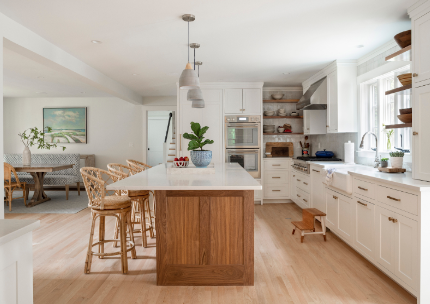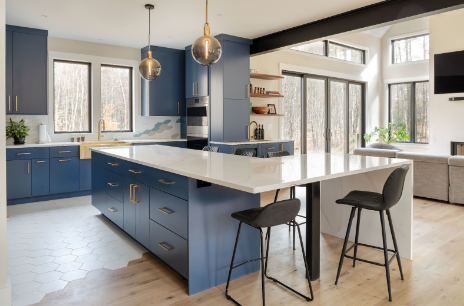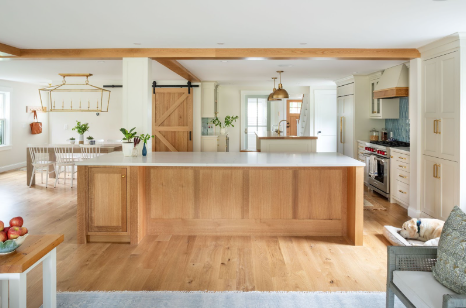;)
;)
;)
;)
In recent years, open-concept living has become a dominant trend in the interior design world, but how do you know if open-concept living is the right fit for your family? Like any design approach, open-concept living comes with its own set of advantages and challenges. In this blog, we will delve into the pros and cons of open concept living from an interior designers standpoint.
Pros
Starting with the pros, we believe one of the most desirable traits of open-concept living is the enhanced social interaction. By physically eliminating barriers such as walls or partitions, open layouts encourage communication and connection, whether it’s among family members or guests. If you’re cooking in the kitchen while entertaining guests in the living room, or supervising your children while preparing meals, open-concept spaces facilitate a sense of togetherness within the home.
Another common goal we hear from families when looking for a more open-concept layout is the desire for a brighter space. Opening up the layout of your home can allow light to flow freely from one area to another, creating a bright and airy atmosphere. Open layouts can also increase the airflow within your home, which is always a plus for the homeowners!
Lastly, we have discovered that open-concept living is especially beneficial in smaller homes. By eliminating unnecessary walls, square footage can be utilized more efficiently, making the space feel larger and even more expensive. This allows homeowners to make the most of their available space without compromising on functionality or comfort.
Cons
Now, we will discuss the cons of open-concept living. Starting out is the compromise of privacy, especially in multifunctional spaces like the living room and kitchen. Noises, distractions, and lack of visual barriers can make it challenging to create secluded areas. For instance, if you are someone who enjoys watching television without distractions from your kids or guests, open-concept living may not be for you.
Another drawback we’ve come across with open-concept living is the restricted storage options it offers. This layout frequently reduces the ability to stow away items that homeowners prefer to keep hidden away. Delegating specific areas for storage becomes challenging amidst the seamless flow of open-plan spaces. Consequently, personal belongings, household essentials, and other items may remain exposed due to lack of storage space. This limitation can be a problem for homeowners who value both the spaciousness of open-concept design and the necessity for discrete storage solutions.
Amy Dutton Home predominantly works on projects in Maine and New Hampshire, which means we consistently encounter a common feature in the renovation of older New England homes. These properties often consist of numerous smaller rooms, rather than embracing the modern trend toward open-concept layouts. Yet, it is within these intimate spaces that the essence of the architecture’s unique ambiance resides. In certain historical homes, altering the layout comprises the house’s charm, while in others, it seamlessly enhances the character of the home without issue.
Conclusion
Now that you are aware of both the pros and the cons of open-concept living, you’re better equipped to make a judgment on what would be right for your family. Here at ADH, we prioritize getting to know our clients’ lifestyle needs and goals before determining which floor layout would best fit them. By understanding your preferences, habits, and priorities, we can tailor our design recommendations to create a living space that perfectly suits your unique requirements.
